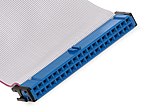Toldja I was clueless!! I use a computer like an electric drill - turn it on, do the job, turn it off. I'm the type that keeps you guys in job security! :8>0
Okay - clean install it is. I might lose some very old programs that I don't have discs for any more, but I guess that's life. I do have a backup of files (500 Gb My Passport USB drive), so (literally) all is not lost. Or ... ?? NewEgg.com has an adapter for installing a laptop drive into a desktop IDE drive bay. If the adapter works, could I install that as a second drive and launch files and programs off that? Files, probably, if the programs are installed on the boot drive, but not programs?
Just wondering if you might have any ideas about my Latitude losing video? I took a road trip with the computer in the trunk (boot?) for about 5 hours. External temperatures were 70-80 F. Big altitude changes from sea level to over 4,000 feet. When I first pulled it out, I could tell it was working but the screen was blank. I let it set in the hotel room for a few hours and tried again - worked perfectly. Got back home and it hasn't worked since, screen or external port. Anything I might be able to look at myself? (I am good with basic mechanical and electrical - just replaced the cover hinges in both mine and my daughter's machines. Hers is still working.)
That can be done, to a small extent. It's going to come down to whether the programs are self contained (meaning they install their working files to one or two directories, namely, in that drive's \program files\ folder), or if they require additional .DLLs or configuration files that are stored elsewhere. Migrating the programs to the new HD can also be accomplished, but again, it is very dependent upon the same factor above.
Usually, more simple programs are self contained - meaning the files are all installed together in the same location (something like \program files\) or else there is only a single file, the program itself, or only a couple of files, the program and a configuration files.
More robust programs that include extra files for whatever reason (.DLLs for, say, being able to make popup windows, edit databases, etc.) used to be installed with the programs as well, but newer software started doing things a bit different - instead of following that old method of everything in the same folder,
common files like .DLLs were moved to the \Windows\system\ or \Windows\system32\ directory, so that your system would not get clogged with 17 different versions of the same file in different folders. This helps reduce that clogged problem, but leads to another problem - the program requires that file, and unless you know which file it is, it's hard to copy the program over to a new system and be able to use it because it also needs that file in another location.
Even more problematic, though, is going to be registry entries. The registry is like a physical database of ... way too many things to list here, but suffice it to say, it stores a lo of settings that previously used to be stored in configuration files. Again, the good news is that now, instead of 17 different config files running around, you have one big repository - but the problem is that, unless you're good at registry editing, again, it hampers your ability to move a program from one machine to another.
So, in essence, you've got about a 1/3 chance of a program on the old HD actually working correctly when that drive is made a slave of the new system.
It won't hurt to try, but be prepared for it to not work.


